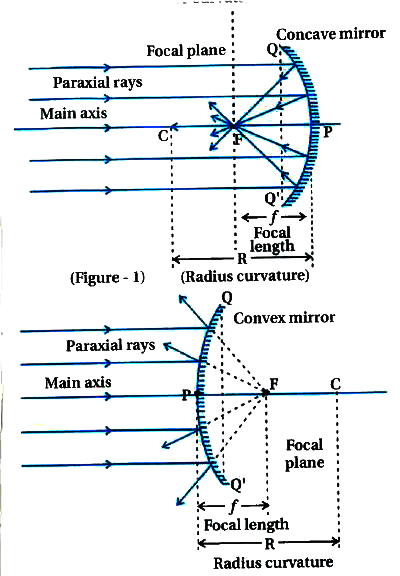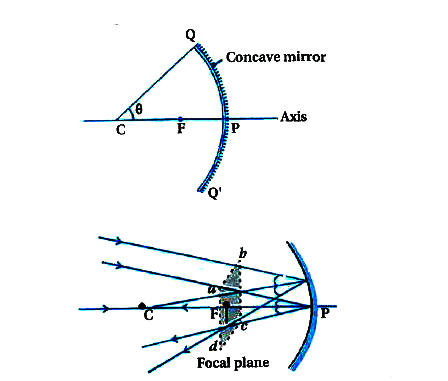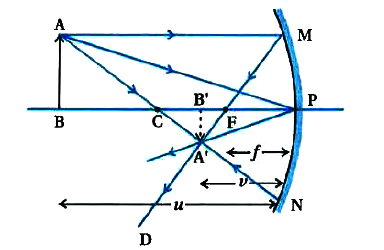Define following for curved mirrors (1) Radius of curvature (2) Centre of curvature (3) Pole (4) Principle axis (5) Aperture (6) Principle focus (7) Focal plane (8) Focal length (9) Paraxial RaysSolution in Gujrati
Radius of Curvature (R) : The radius of the spherical shell from which the mirror is made is called the radius of curvature of curved mirror.

Centre of Curvature (C): The centre of the spherical shell is called the centre of curvature (C) of the mirror.
Pole (P): The centre of the reflecting surface of a mirror is called pole (P).
Principal Axis : The imaginary line passing through the pole and the centre of curvature (CP) is called the principal axis of the mirror.
Aperture : The diameter of the reflecting surface (QQ.) is called aperture of the mirror.
Principal Focus (F) : The point where the rays parallel to the principal axis meet (concave mirror), or appear to meet (convex mirror), after reflection is called the principal focus of the mirror.
Radial Aperture :

Focal Plane : A plane passing through the principal focus and normal to the principal axis is called the focal plane of the mirror.
Focal Length (F) : The distance between the pole and the principal focus of a mirror is called focal length.
Paraxial Rays : Rays close to the principal axis are called paraxial rays.
Topper's Solved these Questions
- BOOK - KUMAR PRAKASHANCHAPTER - RAY OPTICS AND OPTICAL INSTRUMENTSEXERCISE - SECTION - A (TRY YOURSELF)74videos
RAY OPTICS AND OPTICAL INSTRUMENTS
- BOOK - KUMAR PRAKASHANCHAPTER - RAY OPTICS AND OPTICAL INSTRUMENTSEXERCISE - SECTION-B (NUMERICALS)(NUMERICAL FROM TEXTUAL ILLUSTRATIONS)17videos
RAY OPTICS AND OPTICAL INSTRUMENTS
- BOOK - KUMAR PRAKASHANCHAPTER - MOVING CHARGES AND MAGNETISMEXERCISE - SECTION D (MCQs ASKED IN COMPETITIVE EXAMS)34videos
MOVING CHARGES AND MAGNETISM
- BOOK - KUMAR PRAKASHANCHAPTER - SAMPLE QUESTION PAPER EXERCISE - PART-B SECTION-C5videos
SAMPLE QUESTION PAPER
Similar Questions
Give range of wavelength of visible light.
02:04View SolutionSuppose that the lower half of the concave mirror.s reflecting surface as shown in figure is covered with an opaque (non-reflective) material. What effect will this have on the image of an object placed in front of the mirror ?
 01:14View Solution
01:14View SolutionElectric charge Q having mass M moves on a circular path of radius R with velocity →v, perpendicular to uniform magnetic field B. When a particle completes one revolution, work done by the field is _______
06:53View SolutionTwo charges –q and +q are located at points (0, 0, –a) and (0, 0, a), respectively.
(a) What is the electrostatic potential at the points (0, 0, z) and (x, y, 0) ?
(b) Obtain the dependence of potential on the distance r of a point from the origin when r/a>>1 .
(c) How much work is done in moving a small test charge from the point (5,0,0) to (–7,0,0) along the x-axis? Does the answer change if the path of the test charge between the same points is not along the x-axis?View SolutionThe focal length of a convex mirror is 12.5 cm. How far is it centre of curvature (i) from the pole (ii)from the focus?
08:56View SolutionAssertion : If radius of curvature of mirror is doubled, focal length is halved.
Reason : Radius of curvature =2 times the focal lenghtsView SolutionDefine the following for a spherical mirror : (i) principal axis, (ii) radius of curvature, (iii) principal focus, (iv) center of curvature, (v) aperture, (vi) pole.
01:53View Solutiona) An object is kept between centre of curvature and principal focus of a concave mirror. Write the nature of the image formed. b) Define focal length of a convex mirror. Write the relationship between focal length and radius of curvature of a convex mirror.
02:55View Solutiona) An object is kept between centre of curvature and principal focus of a concave mirror. Write the nature of the image formed.
b) Define focal length of a convex mirror. Write the relationship between focal length and radius of curvature of a convex mirror.View Solutiona) An object is kept between centre of curvature and principal focus of a concave mirror. Write the nature of the image formed.
b) Define focal length of a convex mirror. Write the relationship between focal length and radius of curvature of a convex mirror.02:25View SolutionDefine the radius of curvature of a spherical mirror. Find the nature and focal length of a spherical mirror whose radius of curvature is 24 cm.
01:53View SolutionAssertion : If radius of curvature of mirror is doubled, focal length is halved.
Reason : Radius of curvature =2 times the focal lenghts08:03View SolutionThe focal length and radius of curvature of a plane mirror are ?
02:41View SolutionDefine the following terms related to curved mirrors :
(A) Focus (b) Principal axis ( c ) Centre of curvature (d) Radius of curvature02:57View SolutionDefine the radius of curvature of a spherical mirror. Find the nature and focal length of a spherical mirror whose radius of curvature is 24 cm.
View Solution

